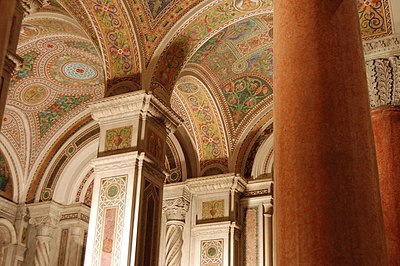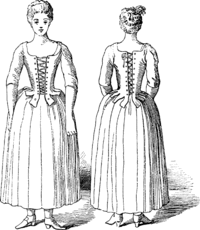Design: Difference between revisions
Removed WP:SPAM and SPAM magnet section |
Designer910 (talk | contribs) added |
||
| Line 127: | Line 127: | ||
'''Commerce''' |
'''Commerce''' |
||
*[[Business design]] |
*[[Business design]] |
||
| ⚫ | |||
*[[New product development]] |
*[[New product development]] |
||
*[[Packaging design]] |
*[[Packaging design]] |
||
| Line 146: | Line 147: | ||
'''Communications''' |
'''Communications''' |
||
*[[Color psychology|Color design]] |
*[[Color psychology|Color design]] |
||
| ⚫ | |||
*[[Communication design]] |
*[[Communication design]] |
||
*[[Content designer]] |
*[[Content designer]] |
||
Revision as of 20:48, 1 July 2007




Design, usually considered in the context of the applied arts, engineering, architecture, and other such creative endeavors, is used both as a noun and a verb. As a verb, "to design" refers to the process of originating and developing a plan for a product, structure, or component. As a noun, "a design" is used for both the final (solution) plan (e.g. proposal, drawing, model, description) or the result of implementing that plan (e.g. object produced, result of the process). More recently, processes (in general) have also been treated as products of design, giving new meaning to the term "process design".
Designing normally requires a designer considering aesthetic, functional, and many other aspects of an object or process, which usually requires considerable research, thought, modeling, interactive adjustment, and re-design.
Philosophies and studies of design
Studying the nature and impact of design (in general) is elusive at best. There is no universal language or unifying institution for designers of all disciplines. Raised levels of achievement often lead to raised expectations. In structuration theory, design is both medium and outcome generating a Janus like face, with every ending marking a new beginning.
There are countless philosophies for guiding design as the design values and its accompanying aspects within modern design vary, both between different schools of thought and among practicing designers.[1] Design philosophies are usually for determining design goals. A design goal may range from solving the least significant individual problem of the smallest element to the most holistic influential utopian goals. Design goals are usually for guiding design; however, conflicts over immediate and minor goals may lead to questioning the purpose of design, perhaps to set better long term or ultimate goals.
Philosophies for guiding design
A design philosophy is a guide to help make choices when designing. An example of a design philosophy is “dynamic change” to achieve the elegant or stylish look you need.
Approaches to design
A design approach is a general philosophy that may or may not include a guide for specific methods. Some are to guide the overall goal of the design. Other approaches are to guide the tendencies of the designer. A combination of approaches may be used if they don't conflict.
Some popular approaches include:
- User centered design, which focuses on the needs, wants, and limitations of the end user of the designed artifact
- Use-centered design, which focuses on how it will be used with less emphasis on the user than user-centered design
- KISS principle, (Keep it Simple, Stupid), which strives to eliminate unnecessary complications
- There is more than one way to do it (TMTOWTDI), a philosophy to allow multiple methods of doing the same thing
- Murphy's Law (Everything that can go wrong will, so plan for it beforehand)
Philosophies for methods of designing
Design Methods is a broad area that focuses on:
- Exploring possibilities and constraints by focusing critical thinking skills to research and define problem spaces for existing products or services—or the creation of new categories; (see also Brainstorming)
- Redefining the specifications of design solutions which can lead to better guidelines for traditional design activities (graphic, industrial, architectural, etc.);
- Managing the process of exploring, defining, creating artifacts continually over time
- Prototyping possible scenarios, or solutions that incrementally or significantly improve the inherited situation
Philosophies for the purpose of designs
In philosophy, the abstract noun "design" refers to a pattern with a purpose. Design is thus contrasted with purposelessness, randomness, or lack of complexity.
To study the purpose of designs, beyond individual goals (e.g. marketing, technology, education, entertainment, hobbies), is to question the controversial politics, morals, ethics and needs such as Maslow's hierarchy of needs. "Purpose" may also lead to existential questions such as religious morals and teleology. These philosophies for the "purpose of" designs are in contrast to philosophies for guiding design or methodology.
Often a designer (especially in commercial situations) is not in a position to define purpose. Whether a designer is, is not, or should be concerned with purpose or intended use beyond what they are expressly hired to influence, is debatable, depending on the situation. Not understanding or disinterest in the wider role of design in society might also be attributed to the commissioning agent or client, rather than the designer.
Design Education
Design Education uses the study of design movements and their sociohistoric significance to teach progressive solutions to human problems. The sociohistoric significance of design encompasses every change and interaction between people and their environment. The use of design education in classrooms and institutions marks an active commitment to human conditions rather than passive intake of information for future regurgitation or commercialization. Studying design teaches us to better formulate the problem to which we seek a solution.

Design as a process
Design as a process can take many forms depending on the object being designed and the individual or individuals participating.
Defining a design process
According to video game developer Dino Dini in a talk given at the 2005 Game Design and Technology Workshop held by Liverpool JM University, design underpins every form of creation from objects such as chairs to the way we plan and execute our lives. For this reason it is useful to seek out some common structure that can be applied to any kind of design, whether this be for video games, consumer products or one's own personal life.
For such an important concept, the question "What is Design?" appears to yield answers with limited usefulness. Dino Dini states that the design process can be defined as "The management of constraints". He identifies two kinds of constraint, negotiable and non-negotiable. The first step in the design process is the identification, classification and selection of constraints. The process of design then proceeds from here by manipulating design variables so as to satisfy the non-negotiable constraints and optimizing those which are negotiable. It is possible for a set of non-negotiable constraints to be in conflict resulting in a design with no solution; in this case the non-negotiable constraints must be revised. For example, take the design of a chair. A chair must support a certain weight to be useful, and this is a non-negotiable constraint. The cost of producing the chair might be another. The choice of materials and the aesthetic qualities of the chair might be negotiable.
Dino Dini theorizes that poor designs occur as a result of mismanaged constraints, something he claims can be seen in the way the video game industry makes "Must be Fun" a negotiable constraint where he believes it should be non-negotiable.
It should be noted that "the management of constraints" may not include the whole of what is involved in "constraint management" as defined in the context of a broader theory of constraints, depending on the scope of a design or a designer's position.

Redesign Something that is redesigned requires a different process than something that is designed for the first time. A redesign often includes an evaluation of the existent design and the findings of the redesign needs are often the ones that drive the redesign process.
Typical steps
A design process may include a series of steps followed by designers. Depending on the product or service, some of these stages may be irrelevant, ignored in real-world situations in order to save time, reduce cost, or because they may be redundant in the situation.
Typical stages of the design process include:
- Pre-production design
- Design brief - a statement of design goals
- Analysis - analysis of current design goals
- Research - investigating similar design solutions in the field or related topics
- Specification - specifying requirements of a design solution
- Problem solving - conceptualizing and documenting design solutions
- Presentation - presenting design solutions
- Design during production
- Development - continuation and improvement of a designed solution
- Testing - in-situ testing a designed solution
- Post-production design feedback for future designs
- Implementation - introducing the designed solution into the environment
- Evaluation and conclusion - summary of process and results, including constructive criticism and suggestions for future improvements
- Redesign - any or all stages in the design process repeated (with corrections made) at any time before, during, or after production.
Terminology
The word "design" is often considered ambiguous depending on the application.
Design and art
 |
Design is often viewed as a more rigorous form of art, or art with a clearly defined purpose. The distinction is usually made when someone other than the artist is defining the purpose. In graphic arts the distinction is often made between fine art and commercial art.
In the realm of the arts, design is more relevant to the "applied" arts, such as architecture and product design. Design implies a conscious effort to create something that is both functional and aesthetically pleasing. For example, a graphic artist may design an advertisement poster. This person's job is to communicate the advertisement message (functional aspect) and to make it look good (aesthetically pleasing). The distinction between pure and applied arts is not completely clear, but one may consider Jackson Pollock's (often criticized as "splatter") paintings as an example of pure art. One may assume his art does not convey a message based on the obvious differences between an advertisement poster and the mere possibility of an abstract message of a Jackson Pollock painting. One may speculate that Pollock, when painting, worked more intuitively than would a graphic artist, when consciously designing a poster.
Design and engineering
 |
 |
Engineering is often viewed as a more rigorous form of design. Contrary views suggest that design is a component of engineering aside from production and other operations which utilize engineering. A neutral view may suggest that both design and engineering simply overlap, depending on the discipline of design. The American Heritage Dictionary defines design as: "To conceive or fashion in the mind; invent," and "To formulate a plan", and defines engineering as: "The application of scientific and mathematical principles to practical ends such as the design, manufacture, and operation of efficient and economical structures, machines, processes, and systems." [2][3]. Both are forms of problem-solving with a defined distinction being the application of "scientific and mathematical principles". How much science is applied in a design is a question of what is considered "science". Along with the question of what is considered science, there is social science versus natural science. Scientists at Xerox PARC made the distinction of design versus engineering at "moving minds" versus "moving molecules".
Design and production
 |
The relationship between design and production is one of planning and executing. In theory, the plan should anticipate and compensate for potential problems in the execution process. Design involves problem-solving and creativity. In contrast, production involves a routine or pre-planned process. A design may also be a mere plan that does not include a production or engineering process, although a working knowledge of such processes is usually expected of designers. In some cases, it may be unnecessary and/or impractical to expect a designer with a broad multidisciplinary knowledge required for such designs to also have a detailed knowledge of how to produce the product.

Design and production are intertwined in many creative professional careers, meaning problem-solving is part of execution and the reverse. As the cost of rearrangement increases, the need for separating design from production increases as well. For example, a high-budget project, such as a skyscraper, requires separating (design) architecture from (production) construction. A Low-budget project, such as a locally printed office party invitation flyer, can be rearranged and printed dozens of times at the low cost of a few sheets of paper, a few drops of ink, and less than one hour's pay of a desktop publisher.
This is not to say that production never involves problem-solving or creativity, nor design always involves creativity. Designs are rarely perfect and are sometimes repetitive. The imperfection of a design may task a production position (e.g. production artist, construction worker) with utilizing creativity or problem-solving skills to compensate for what was overlooked in the design process. Likewise, a design may be a simple repetition (copy) of a known preexisting solution, requiring minimal, if any, creativity or problem-solving skills from the designer.
Process design
 |
 |
"Process design" (in contrast to "design process") refers to planning the routine steps of a process aside from the expected result. Processes (in general) are treated as a product of design, not the method of design. The term originated with the industrial designing of chemical processes. With the increasing complexities of the information age, consultants and executives have found the term useful to describe the design of business processes as well as manufacturing processes.
See also
Design disciplines
Design approaches and methods
Other design related topics
|
Design organizations Design tools |
Studying design |
Impact of design |
Footnotes
- ^ Holm, Ivar (2006). Ideas and Beliefs in Architecture and Industrial design: How attitudes, orientations and underlying assumptions shape the built environment. Oslo School of Architecture and Design. ISBN 8254701741.
- ^ American Psychological Association (APA): design. (n.d.). The American Heritage® Dictionary of the English Language, Fourth Edition. Retrieved January 10, 2007, from Dictionary.com website: http://dictionary.reference.com/browse/design
- ^ American Psychological Association (APA): engineering. (n.d.). The American Heritage® Dictionary of the English Language, Fourth Edition. Retrieved January 10, 2007, from Dictionary.com website: http://dictionary.reference.com/browse/engineering
- ^ Examines the role of embedded behaviour in human environments.
- ^ Concerns the existence and construction of mathematical set systems that have specified numerical properties.
- ^ Actively involving users in the design process.
- ^ Drafting and other forms of modelling.
- ^ Includes economic, environmental and political issues.
External Links
- Seeing design as redesign An essay discussing limitations of the term design (by Jan Michl / DesignAddict)
Design Magazines
- STEP inside design
- ROGER Template:De icon Template:En icon
- Design as Glue, David Kelley & GK VanPatter, NextDesign Leadership Institute Journal, 2006
- International Design Directory Directory of schools, journals, events & professional societies Template:En icon
- Dexigner online design portal delivering design news, competitions, forums and links Template:En icon
- HOW magazine
- myCode online design portal, especially about furniture design (in Czech and English) Template:En icon
- News from design Template:It icon
- d/Visible magazine
